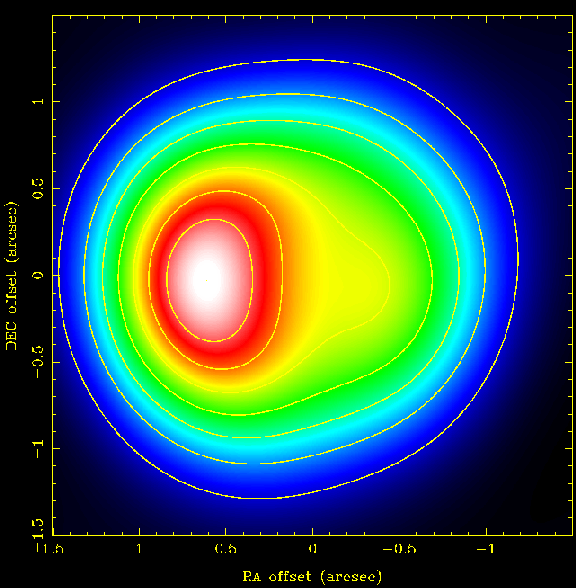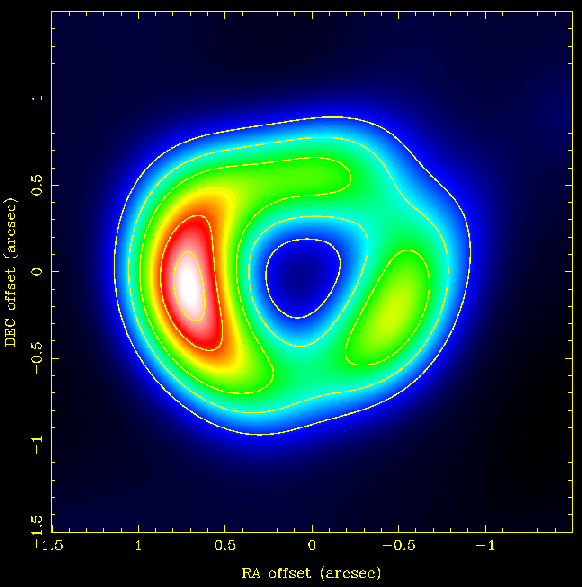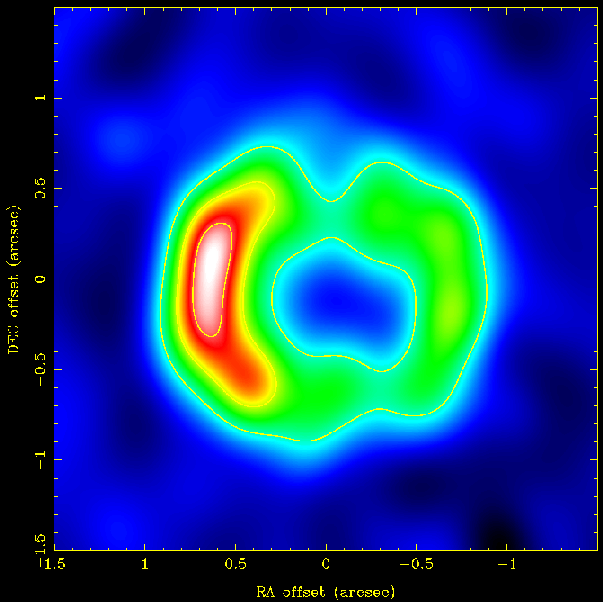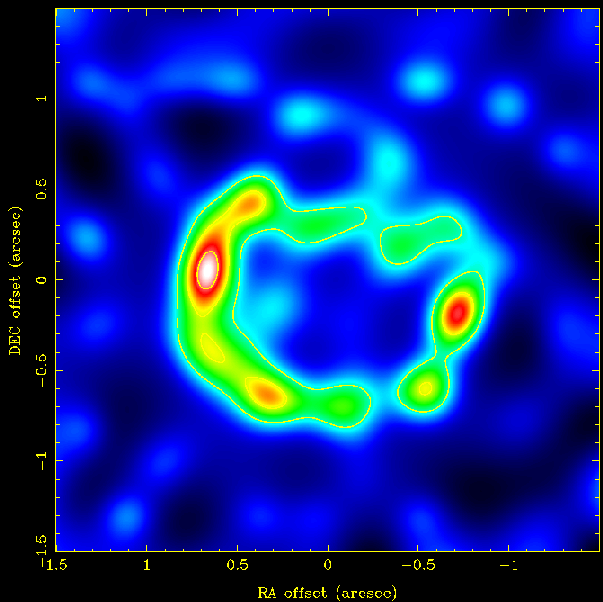The highest resolution image from the Compact Array: SNR 1987A at 12 mm
Obtaining high-resolution images of the radio remnant of SN 1987A to compare with the resolution of the Hubble Space Telescope and Chandra was one of the principal scientific justifications for the 12-mm upgrade of the Compact Array in the 1995 Major National Research Facilities proposal. Eight years later, this goal has finally been achieved. Although three antennas were fitted with 12-mm prototype receivers in September 2001 and we detected the remnant a few weeks later, it was not until April 2003 that 12-mm receivers were installed on all six antennas of the array, giving the 6-km baselines needed for sub-arc-second imaging.
SN 1987A, located in the 30 Doradus region of the Large Magellanic Cloud, was the brightest supernova in nearly 400 years. The supernova was first observed optically on 24 February 1987, a few hours after the explosion, and quickly brightened to about 4th-magnitude. The first radio observations commenced just one day later at Molonglo and Fleurs, at 843 and 1400 MHz respectively, and two days later with the Parkes-Tidbinbilla Interferometer at 2.3 and 8.4 GHz (Turtle et al., 1987). These observations showed a radio burst which reached about 120 mJy in one or two days and then decayed with a timescale of a week or so to become undetectable after a few months. This "radio supernova" phase was very short-lived and under-luminous compared to similar events seen in other more distant galaxies, almost certainly because of the tenuous atmosphere of the exploding star. However, a different "supernova remnant" (SNR) phase of emission was expected when the supernova shock began to plow into circumstellar gas, so monitoring continued at Molonglo and commenced at the newly commissioned Compact Array. Some models predict that the remnant will become very bright when the shock reaches the dense gas seen as the bright inner ring in, for example, Ha images.
Renewed emission was first detected at Molonglo in July 1990, and a few weeks later at the Compact Array. This emission has grown in intensity more-or-less steadily since then and now has a flux density of about 300 mJy at 843 MHz and 200 mJy at 1.4 GHz (Ball et al., 2001; Manchester et al., 2002). It has a power-law spectrum with a spectral index of about -0.9, signifying an optically thin synchrotron source. This spectral index is steeper than the average SNR but the spectrum appears to be getting flatter with time and will have the average index of about -0.5 in just 50 years if present trends continue. By mid-1992 the remnant was strong enough to image at 3 cm with the Compact Array, and images have been obtained at roughly yearly intervals since then. With normal diffraction-limited restoration, these images have a resolution of about 1 arcsec and they barely resolve the SNR. However, use of "super-resolution" techniques (Staveley-Smith et al., 1993) allows us to obtain an image with resolution of about 0.5 arcsec showing that the remnant has a shell-like morphology with brighter regions to the east and west (Figure 1; the web version of this newsletter contains full colour images of all the figures in this article). The shell evidently expanded rapidly in the first few years but slowed down to an expansion velocity of about 3000 km/s some time before 1992 (Gaensler et al., 1997). It currently has a radius of about 0.7 arcsec and is predicted to impact on the dense inner ring in 2004 with an uncertainty of about two years.


Figure 1:(a) Diffraction-limited 3-cm image of the radio remnant of SN 1987A obtained on 1 August, 2003 using the Compact Array in the 6D configuration. (b) Super-resolved image obtained using the Miriad "maxen" routine with a restoring beam of 0.4 arcsec.
Super resolution gives more weight to the long baselines in a data set and also extrapolates into unobserved areas of the u-v plane. It is therefore inherently uncertain. While the consistency of successive 3-cm super-resolved images gave us confidence that the structure they revealed was genuine, there remained some doubt about the fidelity of these images. Since it was not feasible to extend the maximum baseline of the Compact Array, the only way to improve on existing images was to go to higher frequencies. Unfortunately the Earth has a turbulent atmosphere which perturbs the phases and amplitudes of the recorded visibilities. The phase perturbations increase linearly with frequency, and increase with baseline length in a manner which depends on the atmospheric conditions. At Narrabri, for a given angular resolution, we expect the atmospheric phase variations to be more than twice as bad at 3 mm (100 GHz) than at 12 mm (20 GHz). Also, amplitude variations will further limit the dynamic range, especially at 3 mm. Self calibration is difficult because of the small number of antennas and signal/noise limitations, so we expect that the highest resolution images with the Compact Array will be obtained at 12 mm.
This expectation has been wonderfully fulfilled. On 31 July 2003, we had a clear sky and low humidity for the entire 12 hours of an observation of SNR 1987A with the 6D array at two frequencies, 17.345 and 19.649 GHz, within the lower part of the 12-mm band. Atmospheric phases on even the longest baseline (5877 m) varied by less than or about 30 degrees between observations of a phase calibrator (0541-7332) spaced by 12 minutes, so the phase calibration was unambiguous. Observations of Mars were used to calibrate the amplitudes; despite its current closeness to Earth, it was only slightly resolved by the shortest (77 m) baseline, allowing us to bootstrap the calibration to longer baselines via the phase calibrator which was assumed to be unresolved. Within the uncertainties, the measured flux densities at the two frequencies, 25.5 mJy and 24.2 mJy respectively, are consistent with the extrapolation of the cm-wavelength spectrum. Data at the two frequencies were then combined to form a uniformly weighted image and then cleaned. The resulting image, restored with a 0.45 x 0.36 arcsec beam, is shown in Figure 2(a). The similarity of this image to the super-resolved 3-cm image shown in Figure 1(b) is remarkable, giving us great confidence in the super-resolution technique.
The diffraction-limited 12-mm image still does not have the resolution of HST or Chandra images of the remnant, about 0.1 arcsec. These images show "hot spots" around the inner edge of the ring, where it is believed the SN ejecta are colliding with the ring gas. There is some correlation between the hot spots in the optical and X-ray bands. Since we have now demonstrated the reliability of the super-resolution technique, the obvious next step is to try super-resolving the 12-mm image. Our first attempt at this is shown in Figure 2(b), a maximum entropy image restored with a 0.2-arcsec beam. Both the eastern and western lobes have several hotspots in this image. An interesting feature is the appearance of what may be an inner ring with a radius about half that of the main ring and three hot spots.


Figure 2: (a) Diffraction-limited 12-mm image of SNR 1987A obtained on 31 July, 2003 using the Compact Array in the 6D configuration. (b) Maximum entropy image restored with a 0.2-arcsec beam.
Comparison of the super-resolved 12-mm image with the HST and Chandra images shows no clear correlation of the radio hot spots with those at optical or X-ray wavelengths. The radio emission seems to be more correlated with the high-energy X-ray emission detected by Chandra (Park et al., 2002). Further work is needed to explore reliability of the super-resolved image, the mechanism of the radio emission and the detailed relationship of the emission in the different wavelength regimes.
These images represent the culmination of nearly a decade of effort by many people. In particular, we thank the ATNF engineers and technical staff who worked long and hard to make the 12-mm system a reality.
References
Ball, L., Crawford, D.F., Hunstead, R. W., Klamer, I., & McIntyre, V., 2001, ApJ, 549, 599
Gaensler, B.M., Manchester, R.N., Staveley-Smith, L., Tzioumis, A.K., Reynolds, J.E. & Kesteven, M.J., 1997, ApJ, 479, 845
Manchester, R.N., Gaensler, B.M., Wheaton, V.C., Staveley-Smith, L., Tzioumis, A.K., Bizunok, N.S., Kesteven, M.J. & Reynolds, J.E., 2002, PASA, 19, 207
Park, S., Burrows, D.N., Garmire, G.P., Nousek, J.A., McCray, R., Michael, E. & Zhekov, S., 2002, ApJ, 567, 314
Turtle, A. J., Campbell-Wilson, D., Bunton, J.D., Jauncey, D.L., Kesteven, M.J., Manchester, R.N., Norris, R.P., Storey, M.C. & Reynolds, J.E., 1987, Nature, 327, 38
Staveley-Smith, L., Briggs, D.S., Rowe, A.C., Manchester, R.N., Reynolds, J.E., Tzioumis, A.K., Kesteven, M.J., 1993, Nature, 366, 136
Dick Manchester, Lister Staveley-Smith, Bryan Gaensler, Mike Kesteven & Tasso Tzioumis
(Dick.Manchester@csiro.au)
